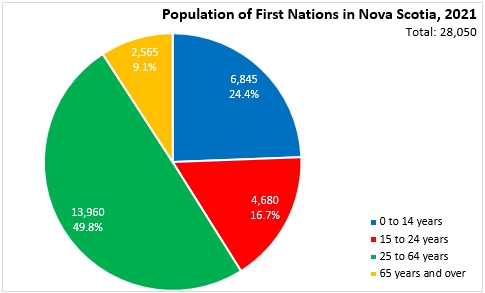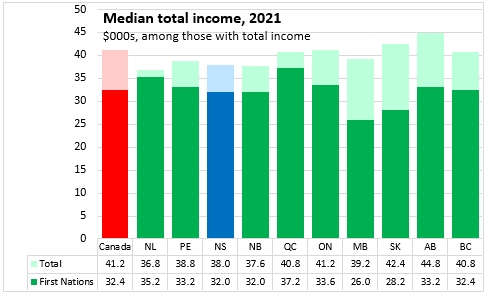The Economics and Statistics Division maintains archives of previous publications for accountability purposes, but makes no updates to keep these documents current with the latest data revisions from Statistics Canada. As a result, information in older documents may not be accurate. Please exercise caution when referring to older documents. For the latest information and historical data, please contact the individual listed to the right.
<--- Return to Archive
For additional information relating to this article, please contact:
September 21, 2022CENSUS: FIRST NATIONS Statistics Canada has released results from the 2021 Census about Canada's Indigenous peoples. Today's article will focus on the First Nations peoples.
In Nova Scotia, there were 28,050 First Nations persons as well as 1,100 Inuit persons. Across Canada, there were 1,048,405 First Nations peoples and 70,540 Inuit.

In Nova Scotia, 15,955 of the First Nations persons were Registered or had Treaty Status, of whom 9,420 lived on Reserve. By community, the largest number of Nova Scotia's First Nations population lived in Halifax (8,385), followed by Eskasoni (3,430), Cape Breton Regional Municipality (1,500), Indian Brook (1,130), Membertou (1,000), Whycocomagh (845), Millbrook (755), Queens Regional Municipality (660) and Wagmatcook (645).
Just under one quarter of Nova Scotia's First Nations population was under the age of 15 while 9.1% were 65 years old or older.

Nova Scotia's First Nations report children as a higher share of the population (38.8%) than the provincial average (25.0%).

The median total income of Nova Scotia's First Nations population was $32,000, which was 84.2% of the provincial median income. Nationally, median income of First Nations populations was $32,400 or 78.6% of the national median income. Across provinces, median incomes of First Nations populations were highest in Quebec and lowest in Manitoba.

Source: Statistics Canada. Table 98-10-0281-01 Income statistics by Indigenous identity and residence by Indigenous geography: Canada, provinces and territories; Table 98-10-0276-01 Household and family characteristics of persons including detailed information on stepfamilies by Indigenous identity and residence by Indigenous geography: Canada, provinces and territories; Table 98-10-0264-01 Indigenous identity by Registered or Treaty Indian status and residence by Indigenous geography: Canada, provinces and territories; Table 98-10-0266-01 Indigenous identity by Registered or Treaty Indian status: Canada, provinces and territories, census divisions and census subdivisions
<--- Return to Archive